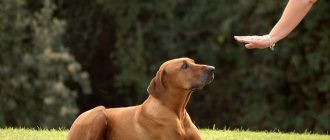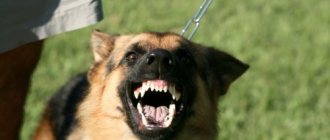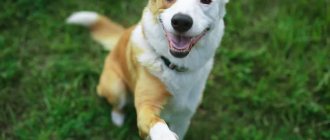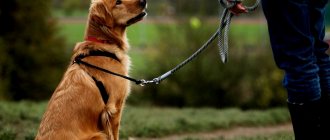- 19.11.2017
- Training, Animals, Dogs, Articles, Explanatory
The “Down” command is one of the components of the basic set of commands for dogs. It is used in everyday life, but is especially necessary in non-standard situations: for example, when visiting a veterinary clinic or traveling on an intercity train. Therefore, the question of how to teach a dog the “Down” command interests every responsible owner at a certain stage of raising a pet.
Why is the “Down” command needed?
Before you begin training, you should understand why such a command might be needed at all. Many breeders do not know the answer to this question, which is why they cannot work really effectively during training.
In everyday life
For example, when visiting a veterinarian, the dog should lie down so that the specialist can carefully examine it and, if necessary, give an injection or take blood for analysis. In this case, the dog must be motionless so as not to cause unnecessary difficulties. Of course, the corresponding command is perfect here if the pet has really learned it firmly.
On a note! Even if the dog remembers the command well, you should remember it at least several times a week - then he will obey it unquestioningly.
In addition, dog lovers often give such a command during a hunt - of course, this only applies to hunting breeds. In this position, the animal can remain motionless for much longer than in a sitting or standing position. At the same time, it does not experience discomfort and at the same time, the risk that the prey will notice the hunter ahead of time is almost completely eliminated.
Finally, if the adult dog knows the command well, it can be useful at home. Brushing teeth, trimming nails, examining ears - all these hygiene tasks become much easier if the pet lies still.
Standard
Knowing the team will come in handy not only at home, but also at exhibitions. After all, when assessing a dog, experts will definitely check its endurance, that is, the ability to not move for a long time, to freeze in one position.
It is quite clear that lying down the dog experiences much greater comfort than standing or sitting. Therefore, the likelihood that she will break down and violate the command is sharply reduced. Because of this, the Down command is most often used when checking endurance.
Tips for the caregiver
When you decide to start learning commands, be sure to follow a few rules. Since you will be working on positive training methods, do not punish the four-legged for failure. There may be moments of doubt as your dog may have trouble reading your sign. However, it is important to have patience and a positive attitude. The animal quickly feels nervous and stressed.
Workouts should not take you more than 15 minutes at a time. After this time, the dog will get tired and his willingness to follow orders will quickly end. Remember that you will achieve the best results by following one command. You can use "down" instead of "lay down". The basis is the choice of one specific word.
The “down” command is one of the commands that your dog should be able to do at all times, because it is often useful when you need to control (not always good) emotions.
At what age should you start training a puppy?
Treats are an important part of training.
A very important question is at what age should a pet be taught to follow a command. Of course, it is best to do this while he is still small. The optimal age is about 3-4 months. Moreover, this applies to breeds of different sizes - both Spitz or Chihuahua, and retrievers, pit bulls.
At this age, the dog is already smart enough to understand what the owner wants from him, and at the same time he is very flexible - he does not try to show dominance, which can seriously interfere with the learning process.
Well, having remembered a command from childhood, the pet will unquestioningly carry it out in the future, of course, provided that it recognizes the owner as a leader.
How long will it take?
Every dog learns at a different pace, just like people, so be patient. Learning to sit and lie down are fairly simple skills for dogs, so it shouldn't take long. It also depends on how much time you invest in the process and the frequency of training. In order for the dog to learn faster, training must be done daily, otherwise the animal, without consolidating the skill, will forget everything and will have to start all over again.
The optimal training time is 30 minutes; with an adult dog you can train for about an hour. If you try to train your four-legged friend for longer periods of time, you risk becoming frustrated, distracted, bored, or just plain tired.
Basic recommendations and rules
To begin with, training should be regular. You can’t think about them once a week, spend half a day on your pet and wonder why he doesn’t want to learn to follow commands. No, it’s better to allocate only 15-20 minutes, but every day, for example, in the evening, before feeding.
By the way, the latter is a very important rule - it is best to teach on an empty stomach. A well-fed dog no longer wants to follow the command - he wants to rest, lie down in a corner while the food he eats is digested. Yes, and consolidating a positive result with the help of treats will no longer give the same effect as we would like.
Healthy! Depending on the breed of the dog, both carrots and sticks can be used during training, that is, light physical punishment.
It is very important that the dog not only lies down, but also remains in this position until a new command is received from the owner. Otherwise, we can assume that he did not learn the command, and the training turned out to be useless.
Actionable recommendations
To make learning a new skill easy for you and your animal, follow these helpful tips:
- Reward your dog only for complete execution of the command. If your dog sits down but then immediately gets up, do not give him a treat.
- Make sure that all members of your family engage in animal training. It must unquestioningly obey everyone who can go with it for a walk.
- Always wait for the animal to obey your order. Do not repeat it several times, otherwise the dog will get used to it and will not carry out the command right away.
- Address the dog in an even, calm voice with a commanding intonation. Don't intimidate him, don't yell at your pet. This will make training more difficult.
- Practice the command outside of training. Always give it to your pet before placing a bowl of food in front of him. This technique will increase the duration of the order and make it more familiar to the dog.
- Always be careful when choosing a place to study. Do not train in areas where something could injure your pet, and do not place it in wet ground. These circumstances will not allow the pet to quickly master the skill.
- As training progresses, reduce the amount of treats given to the animal for correctly following the order. Replace food with verbal encouragement and stroking.
- Do not punish the animal if it is poorly trained. So he will lose interest in classes. It's better to work with him using a different method. If none of the training methods that you know give the desired result, seek help from dog trainers. They will find an approach to any animal, including representatives of temperamental, disobedient breeds.
- Complete each execution of the “Sit” command with another order: “Stand” or “Come to me.” Keep a pause between them: at first it should be at least five seconds, gradually its time can be increased. This way you will teach the dog to jump up voluntarily.
- When the animal has mastered the command well, you can move on to training in noisy places: on a busy street, in a store. The pet must understand that the owner’s will must be carried out in any environment.
- During class, give all orders in clear, one-syllable sentences. The simple word “Sit” is enough. The longer your appeal to your pet is, the more difficult it will be for him to understand what they want from him. This applies to all the skills that you will need to practice in the general training course.
After you have learned the “Sit” command with your animal, introduce it into daily training from time to time. Remember, if your pet is not constantly trained, he may lose the acquired skills, and you will have to start working with him from the very beginning.
What is needed for training
The command can be made more complex
When starting training, you need to remember certain conditions - without them, it will be more difficult to teach the dog a command. First of all, this is a comfortable collar. The pet should not be distracted by external stimuli, but should fully concentrate on learning. The collar must be equipped with a short leash - it will be useful during training.
Also, don't forget about treats. Dog biscuits, dried lung, and any other compact treat that your pet loves will do. They are used to consolidate the result obtained - without this, things will move much more slowly.
Finally, the owner must be in a good mood. This is really important - a tired and angry person will hardly be able to remain calm for long. And if he constantly breaks down and shouts at the dog, then the training will definitely not be successful.
Why should you train your dog?
Training sessions with your pet bring many benefits in everyday life:
- Creating a strong relationship - the guardian should be the dog's guide around the human world and familiarize him with the rules that apply, for example, in city parks. Spending time together will allow you to learn about your pet's capabilities and limitations. In turn, the animal will learn from you the rules that should be followed in order to live in peace and happiness.
- Mental activity for a dog - I will never forget during group dog training, the behaviorist said that a quarter of mental activity is like walking the dog for an hour. Your dog will certainly appreciate it if you treat him to regular training sessions where new challenges await him.
- Keeping fit - You can walk often and for long distances, which affects your fitness as well as various physical activities. Your dog's body requires them just as much as yours. After cardio or strength training you feel completely different than after a walk, right? It's great for your pet to do a variety of physical exercises on a regular basis, even during training.
Where to conduct classes
Another very important question. In general, this can be any place - a playground or a park, or an apartment. But still, most dog trainers recommend training the dog at home at least in the first stages - there are fewer factors that could distract it from the learning process.
After the command has been learned and reinforced, you can further reinforce it on the street, when there are many unusual smells around and dogs are running around, distracting the pet from discipline. This will be a great test.
Remember! Before you start training, it’s a good idea to watch how professionals work - this will help you avoid many mistakes.
It would not be right to forget about the comfort of your pet. The surface on which it is placed must be clean, dry and level. Of course, if you force him to lie down on sharp stones or in a puddle, then it will be much more difficult to cope with the task. After all, training should not be associated with unpleasant sensations and discomfort - it should bring joy to both parties.
Basic principles of training
You can teach simple tricks to even a two-month-old puppy - the main thing is to repeat and consolidate what you have learned every day. To guarantee success, several things are required:
- Patience on the part of the owner and trust on the part of the puppy. To earn this trust, it is important to be consistent, not to cancel commands already given, and patiently wait for their execution. You can't get irritated, scream, or hit. Germans sometimes require physical force (we'll talk about this later), but obviously not beating and not at that age. A stern voice is enough for now. Test of trust - the call “Come to me!” Along it, the shepherd should joyfully rush to the owner.
- Something delicious. Verbal encouragement is, of course, good, but the baby will work harder for a tasty treat. Cookies, a piece of cheese (necessarily hard and not salty) or sausages - choose what your pet likes and “reward” him for obedience.
- The right time. You should not train your baby 24 hours a day. During training, he should not feel tired, hungry or, conversely, too full. It is best to practice in the morning or on an evening walk.
- "Magic word". Before you start training a German Shepherd, you need to sternly and calmly tell him “Train!”, and then sit him near his left leg. Soon the mere sound of this word will put the animal in a working mood.
How to teach your dog the “Down” command
The command must be carried out unquestioningly.
Most breeders would like to know how to teach a dog to lie down without the help of a dog handler. It makes perfect sense - not only is it fun and convenient, but it also forms a stronger bond between owner and pet.
So, how to train your pet? There are several options here - it will be useful to talk about each of them so that the breeder chooses the one that suits him best.
Food method
This is perhaps one of the most effective and reliable ways to teach a dog a command. The main thing is to do everything right:
- The dog is to the left of the owner, who is holding a leash in his hands.
- The dog is shown a treat and at the same time the command “Lie down!” the hand with the food moves down and forward - the dog involuntarily reaches for it.
- The leash does not allow the pet to walk and she is forced to lower herself, taking a semi-lying position.
- A little pressure is applied to the withers so that the dog lies down. When she is fixed in this position, the encouragement “Good!” follows. and the treat is given to her.
The main thing here is to ensure that the pet remains in this position for as long as the owner says.
Mechanical method
You can do without treats. Here the process is even simpler, but it usually takes longer for the dog to remember the command.
- A leash is put on the dog.
- With one hand the trainer pulls the leash, and with the other he presses lightly on the withers, at the same time the command “Lie down!” is given.
- The dog is forced to lie on its stomach, after which it is petted and praised.
It is important to act carefully here so that the dog does not fall on its side or experience discomfort. Indeed, in the future, all this will be connected in his subconscious with training and execution of commands.
Why should you teach your dog the sit command?
It is important that your dog learns the "sit" command as it is one of the first commands he should learn. It is also the basis for other behaviors she must learn, so learning the sit command is the start of a great experience for the animal and a great experience for you. Training a dog is a great way to bond with its owner. The more often you practice, the better your pet will understand how to act in a given situation.
The main mistakes that dog owners make during the training process
Proper training makes control easier.
Alas, novice breeders quite often make mistakes. At first glance, they are insignificant, but it is because of them that training is delayed and becomes less effective. And it doesn’t matter who you have to work with - a Yorkshire terrier or an Alabai.
It is important that the dog understands what is required of him and wants to carry out the owner’s command. So, here are some mistakes to keep in mind:
- You cannot issue a command several times in a row. It should sound once, but in a firm voice - it is important to show unconditional dominance over the dog, otherwise it simply will not obey - this is the law of the pack.
- You can't misrepresent the command. For example, by saying “Lie down” once, and “Lie down”, “Lie down” or “Lie down already!” at other times, the owner unwittingly knocks down the dog. She doesn't understand that all these commands mean the same thing. Therefore, he cannot respond adequately.
- You cannot simultaneously train several commands, for example, “Sit”, “Lie down”, “Voice”, “Give me a paw”. First, the dog must firmly learn one, and only then, after a quick test of knowledge, move on to the next.
Ways of learning
From a sitting position
Before moving on to the “Down!” command, the pet must perfectly execute the “Sit!” command. So, you order the dog to “Sit!”, then put one hand on the withers, command “Lie down!”, and with your free hand, bending slightly, show the treasured piece of tasty treat almost right to the ground.
It is important to hold the treat in such a way that your pet has to reach forward and down for it. At this moment, you hold the withers and do not allow the dog to stand up. As a result, she assumes a prone position. Now it’s time to give the dog a treat, actively praise it in a gentle voice and cancel the command, releasing the dog with the words “Go for a walk!”
There are some pets that do not lie down and are not attracted to treats at all. At this moment, they just sit, move their nose, turn their heads to the sides, and perhaps stretch their necks out of interest. This behavior should not be encouraged. You should repeat the order loudly and confidently, and pull the leash down.
There are times when the dog resists in every possible way, sits down or tries to get up. In this case, you should watch for the moment when the dog is about to lie down and quickly give the order “Lie down!” It turns out that the pet did not lie down on its own, but followed the owner’s command. In such situations, the owner should be more persistent and not give up. It may take more time, but if the owner does not back down, the pet will obey.
Footrest for front legs
The second option, which allows you to train the animal, is that you put one hand on the dog’s withers, and put the other behind the front limbs, so you seem to be tripping the dog, then the order “Lie down!” is given. At this time, you press on the withers with one hand and push forward with the other. After completing the command, give the treasured treat and cancel the order.
You can pull the leash forward and down while simultaneously pressing on the withers. This will force your pet into a lying position. The command “Lie down!” for your dog after training it will be easy, and you won’t even have to press on the withers.
Now gradually increase the length of time between lying down and the “yummy”. A three month old puppy is trained at 5 second intervals. The baby is impatient, jumps up and expects encouragement, don’t be upset, be patient and give the command one more time.
By gesture
If you have trained your dog to carry out a command in the first two ways, then you can move on to using a gesture. The right hand is raised and placed horizontally, palm facing down, then lowered to the right thigh. During exercise, increase the distance between you and your pet to 3 m, and the waiting time to 7 seconds.
After your pet is 4 months old, gradually continue to increase the distance and waiting time, aiming for the pet to follow orders from 15 m with a hold of 15 seconds at 8 months of age.
When conducting classes, do not shout from afar, canceling the command, calmly approach the dog, pat the ear, showing approval, give a “yummy” and command: “Walk!” Now you can try giving orders in a supermarket, on the street.
To execute the command “Lie down!” in non-standard conditions, the pet should be trained for up to 10 months.
Pay attention to the correct position of the dog while he is in a prone position. The body should be straight, the front legs extended, and the hind legs tucked under.
Advice from experienced trainers
Training will become even more effective if the breeder remembers certain tips given by experienced dog handlers:
- The voice command should be primary, and actions should be secondary.
- If the command is not carried out the first time, a second one is given in a harsher voice.
- Any correct performance should be rewarded - with a word, a treat or stroking.
In general, any dog can learn the “Down” command, especially if you start training from childhood. This will help you get rid of many difficulties in the future.
Patience and systematicity are the most important thing
Don't demand quick results from yourself and your dog. Exercise little but often. Don't take long breaks. Raising a puppy takes time. There is no need to rush: the command “Lie down” is a kind of foundation that needs to be laid correctly. And if we are talking about an adult pet, be even more patient. After all, the ability to carry out the command “Give me your paw” does not mean obedience and learning ability.
© Lifeo.ru
How to stop barking all the time
A service dog should generally bark only at the command of its owner.
In order to wean your German Shepherd from barking at the slightest noise, you can use several methods.:
- Divert the dog's attention to something else: for example, show the puppy a toy, but not give it away for a while, so that he does not decide that the owner wants to reward him with a game for barking so menacingly.
- Spray the dog with water from a spray bottle.
- Approach the dog and, holding your hand over its mouth, sternly say: “Be silent!”
- Ignoring. Make the shepherd silent, and then ignore it for a while. The owner’s reluctance to communicate with the pet is a serious punishment for such a people-oriented dog as a shepherd.
- Silence using the “No!” command. After this, you need to send the dog to the place and force it to stay there for some time.
When weaning a shepherd dog from barking constantly, you cannot use forceful methods of influence . It is also unacceptable to shout at your pet.
Training age
The moment you start training is of great importance. A shepherd, like a person, matures gradually and, like a child, has certain sensitive periods when it is necessary to teach the puppy commands. If you start training it earlier, you will be able to discourage the dog’s desire to come into contact with a person and listen to him; if you start later, you will have to overcome the puppy’s character and incorrectly formed habits, which will not be easy to do.
At the age of 5 months, the shepherd dog should have formed a basic pre-Command to “lie down” for a German shepherd puppy is of great importance, since it is basic and basic. Its study will require certain compliance with the conditions associated with the characteristics of the breed.










